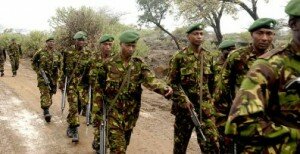Kenya’s much-hyped ‘invasion’ of Somalia a strategic miscalculation
 The invasion of another country is calculated to achieve one or a combination of several strategic outcomes. The strategic outcomes include:
The invasion of another country is calculated to achieve one or a combination of several strategic outcomes. The strategic outcomes include:
To establish authority or pacification in a territory whose lawlessness affects the invader’s territory, to force partition, and to liberate a region or country from the occupation of another.
I call it invasion by virtue of Kenyan troops crossing the international border in force to conduct large-scale operations in a region under the indisputable juridical and territorial sovereignty of Somalia.
The immediate strategic objective for the Kenyan brigade is to control Somalia’s seaport of Kismayu, which is the artery supplying Al-Shabaab, and possibly connects the militants to pirates.
Kismayu is important for troops resupply or reinforcement, the monitoring of sea lanes of communication to the West, and the evacuation and treatment of casualties.
It will be the springboard for future international humanitarian effort to Jubaland. However, Somalia’s coastline covers nearly 1,800 kilometres and the strategic choke-point is not Kismayu area but further north where the Gulf of Aden meets the Red Sea.
Hence, controlling Kismayu does not significantly address the insecurity Somali pirates pose to the shipping lanes of the Indian Ocean.
Many people of Jubaland do not support Al-Shabaab. Nevertheless, they lack the security apparatus that could keep the militants out, and their opposition has not crystallised into resistance.
The inept Somali Transitional Federal Government is to blame for not policing Jubaland. As a result, a security vacuum was created which Al-Shabaab filled.
In the immediate term, our infantry brigade will find it difficult, if not impossible, to achieve the pacification of Jubaland without local support.
In the long term, the lack of a local clientele group through which Kenya and its allies could change hearts and minds and nurture economic and political stability of the “liberated” region makes the invasion a strategic miscalculation.
Despite receiving massive air support from the USA, which will not be indefinite, Kenya is ill-prepared for the security situation that will emerge, mainly, how to deal with two factors.
First, the driving force of Al-Shabaab in the Horn of Africa, particularly inside Kenya and Somalia. Secondly, how to manage critical uncertainties in Jubaland and western Somalia, which border Mandera, Wajir, and Garissa.
In the first week of the invasion, the US has supported Kenya with real-time intelligence and drones to destroy Al-Shabaab targets. High civilian casualties makes this strategy unsustainable in winning local support.
Al-Shabaab combatants could swap military fatigues for loin-clothes, hide their weapons, and melt away into the civilian population from where they will wage nibbling attacks.
That they have threatened and are able to carry out lone wolf attacks deep into Kenya is most worrying.
The second factor relates to the uncertainties born of Somalia’s fragmentation since 1994 and the inability of the international society to predict future trends.
Kenya’s invasion is, so far, strategically limited to the geographical area of southern Somalia. The occupied region is seeking to secede and form an independent country known as Jubaland or Azania.
On the one hand, a stable client state in the shape of an autonomous Jubaland provides Kenya a strategic buffer from the lawlessness in Somalia.
On the other, support for Jubaland’s quest reinforces the continued fragmentation of Somalia as it could become yet another fiefdom.
It is important to consider the cost-benefit equation as, when they choose to attack, Al-Shabaab will employ cheap means, such as land mines to exploit the vulnerabilities of regular ground troops and achieve costly outcomes.
Deploying an infantry brigade 200 kilometres from the Kenya-Somalia border into a hostile environment has its attendant logistical difficulties.
Movement by road during the rainy season is difficult as bogged down vehicles become easy picks for militants and opportunistic bandits.
In conclusion, the invasion is a strategic miscalculation for not addressing the following key questions:
How long is the occupation and at what cost to Kenya? Whose war is Kenya fighting? What is Kenya’s return on investment?
Is the war legal? Is a military invasion the most sensible projection of power into a country where 750,000 people are at risk of death from starvation, typhoid, cholera and measles?
Somalis fight each other ferociously until a stranger appears on the scene, then they suspend their traditional feuding to face the common enemy.
Kenya needs to consider other dynamics of asymmetrical warfare that apply in a situation where an invasion takes place in a territory controlled by non-state combatants.
Arguably, the effectiveness of the invasion as a strategy for neutralising non-state combatants, specifically Al-Shabaab, is questionable as it leaves out apolitical bandits, pirates, mercenaries, and opportunistic criminal groups.
The latter act in small covert cells, are not confined to a specific part of Somalia, and given that their attacks are not linked to any doctrine of war, can continue to cause widespread insecurity, which will ultimately undermine the invasion. In such a situation, a clear exit strategy is a must.
____
Mr Mburu is a former Kenya Army officer, an academic based in the UK, and the author of several publications including ‘Bandits on the Border: the last frontier in the search for Somali Unity’.
Comments
comments
 Calendar
Calendar






































